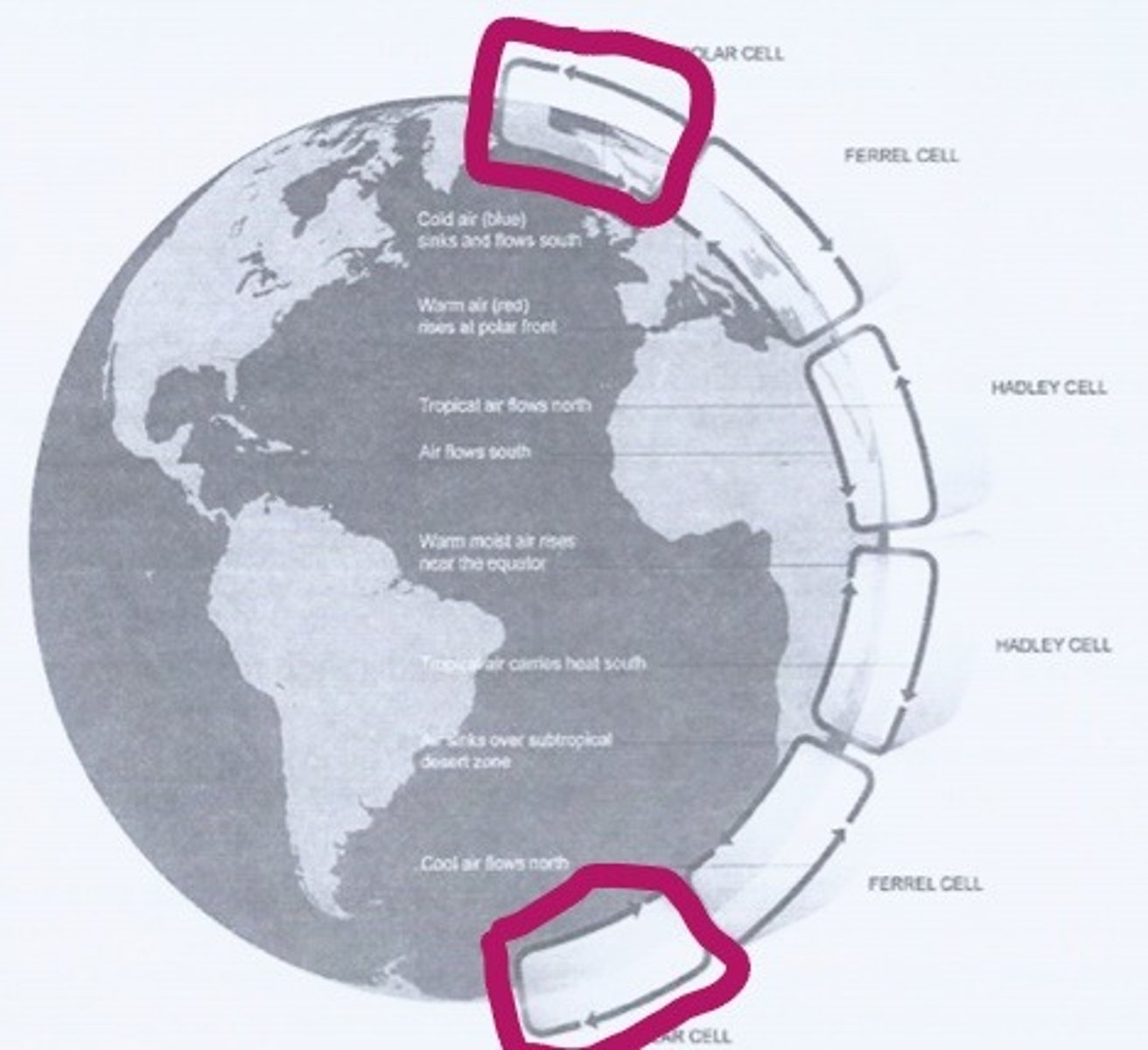GCSE Geography - global atmospheric circulation
1/29
There's no tags or description
Looks like no tags are added yet.
Name | Mastery | Learn | Test | Matching | Spaced |
|---|
No study sessions yet.
30 Terms
What is atmospheric circulation?
The large scale movement of air by which heat is distributed around the Earth.
What does atmospheric circulation help to explain?
The location of world climate zones and the distribution of weather hazards.
What is the most important influence on worldwide variations in climate?
latitude
Why is it warmer at the tropics than at the poles?
At the equator, the suns energy is more focused out over a smaller area due to the lesser curvature of the earth.
Why is it colder at the poles than at the tropics?
At the poles the suns energy is more spread out over a larger area due to the greater curvature of the earth.
Explain how particles floating in the atmosphere influence the temperature at the poles.
Particles floating in the atmosphere (pollution, ash, dust) absorb some of the sun's heat before it hits the ground. At the poles, the sun's rays pass through more atmosphere which means it is cooler on the ground.
What creates high pressure?
In cold air, molecules are packed tightly together - the air becomes denser and begins to sink. The air now presses on the Earth's surface, creating high pressure.
What creates low pressure?
In warm air, particles spread further apart meaning they are less dense and lighter and therefore they rise, creating low pressure.
Which area of the earth receives the most heat? What does this mean (in terms of pressure)
The equator - the air will be warm and will rise causing low pressure.
Which area of the earth receives the least heat? What does this mean (in terms of pressure)
The poles - the air will be cooler and will sink causing high pressure.
Air moves from ____________ to _____________ pressure.
high
low
What is wind caused by and what does it transfer?
CAUSED BY air moving from high pressure to low pressure.
TRANSFERS heat from the tropics towards the poles, in a giant conveyor belt.
What are the 2 ways that heat is transferred around the globe?
wind, ocean currents
Explain what the Coriolis effect is?
When surface winds are deflected to either the left or right of the equator (depending on the hemisphere) due to the spin of the earth.
Define global circulation.
The world wide system of winds by which the transport of heat from tropical to polar latitudes is accomplished.
What are surface winds and what are they caused by?
Surface winds are the winds we experience at ground level.
CAUSED BY air pressure belts
Which direction do the prevailing winds in the UK come from?
South West
Describe the links between circulation and the ecosystem Tropics.
-warm air rises at the equator causing low pressure
-the warm moist air rises and cools and condenses to form clouds
-these clouds rain in the afternoon (convectional rainfall)
Describe the links between circulation and the ecosystem 30 degrees north of the equator
-air is falling at this latitude causing high pressure.
-falling air does not cause clouds so the air is dry, which causes dry conditions (deserts)

Describe the links between circulation and the ecosystem 60 degrees north of the equator
-air is rising and causes low pressure
-clouds formed be rising, cooling air cause rain and the temperatures result in temperate deciduous forests.

Describe the links between circulation and the polar regions
-air is falling and causes high pressure
-falling air warms and so can hold more moisture so clouds do not form
-the latitude makes the temperatures very cold
Where is the Hadley cell located?
the equator to between 30 and 40 degrees north and south

Describe the circulation in a Hadley cell.
-winds blow towards the equator
-ascend near the equator (forming the Inter Tropical Convergence Zone as a broken line of thunderstorms)
-the air flows towards higher latitudes and sinks, producing high pressure regions over subtropical oceans and hot deserts.
Where is the Ferrell Cell located?
between 60 and 70 degrees north and south. (it often occurs around the latitude of the UK)

Describe the circulation in a Ferrell Cell.
a flow of air at high altitudes towards the tropics, where it joins sinking air from the Hadley Cell
The Ferrell Cell moves in the __________________ direction to the Hadley and Polar cell.
opposite
Where is the polar cell located?
extend from between 60 and 70 degrees north and south, to the poles

Describe the circulation in a polar cell.
-sink over the highest latitudes
-flows out towards the lower latitudes at the surface
The effect of the three circulation cells and the influence of the Coriolis effect results in ____________________________
global circulation
Explain the UK's weather, in terms of global circulation.
- warm moist air from the tropics gets fed north by the surface winds of the Ferrell cell.
- this meets cool dry air moving south in the Polar Cell.
- the polar front forms where these two contrasting air mass meet, causing ascending air and low pressure at the surface.